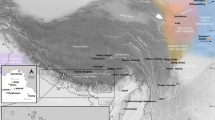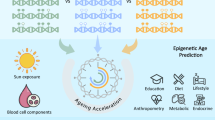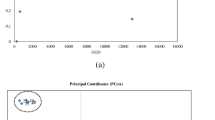Abstract
In the previous studies, the populations in Tibet exhibited a complicated genetic structure, indicating that those populations might be the admixture of East Asian and South/Central Asian populations, or have a North Asian origin. However, there have not been sufficient genetic data to support this hypothesis. In this study, we analyzed 15 autosomal polymorphic tetranucleotide short tandem repeat loci (D5S818, FGA, D8S1179, D21S11, D7S820, CSF1PO, D3S1358, TH01, D13S317, D16S539, D2S1338, D19S433, vWA, TPOX, D18S51) for three populations from Tibet, namely, Deng/Mishmi (n=114), Qamdo Tibetan (n=78) and Lhasa Tibetan (n=101). The total number of observed alleles and the average heterozygosity for all samples were 394 and 0.7574, respectively. Analysis of molecular variance and estimated GST (0.0198) for these allele frequency data suggested the genetic divergence among Tibetan populations was significant. Furthermore, our new allele frequency data for 13 loci were compared with those of 41 world populations previously reported. Results from phylogenetic and multidimensional scaling analyses indicated that: (1) the Deng in Tibet has unique genetic characteristics different from the Tibetans; (2) populations living in the Himalayas area (Deng, Luoba/Adi) composed of a distinct cluster and are closely related to each other than to any other ethnic groups in East Asia; (3) the Tibetans are most similar to the North Asians. This genetic structure is consistent with the geographical barriers and linguistic classifications.
Similar content being viewed by others
Log in or create a free account to read this content
Gain free access to this article, as well as selected content from this journal and more on nature.com
or
References
Huang, G. X. Ethnic Recognition in China (The Ethnic Publishing House, Beijing, 1995).
Guan, D. S. Grand Sight of the Ethnic Cultures in China, Tibetans, Monba, and Luoba, 1st edn (Encyclopedia of China Publishing House, Beijing, China, 1995).
Du, R., Xiao, C. & Cavalli-Sforza, L. L. Genetic distances between Chinese populations calculated on gene frequencies of 38 loci. Sci. China C Life Sci. 40, 613–621 (1997).
Starikovskaya, E. B., Sukernik, R. I., Derbeneva, O. A., Volodko, N. V., Ruiz-Pesini, E., Torroni, A. et al. Mitochondrial DNA diversity in indigenous populations of the southern extent of Siberia, and the origins of Native American haplogroups. Ann. Hum. Genet. 69, 67–89 (2005).
Gayden, T., Cadenas, A. M., Regueiro, M., Singh, N. B., Zhivotovsky, L. A., Underhill, P. A. et al. The Himalayas as a directional barrier to gene flow. Am. J. Hum. Genet. 80, 884–894 (2007).
Torroni, A., Miller, J. A., Moore, L. G., Zamudio, S., Zhuang, J., Droma, T. et al. Mitochondrial DNA analysis in Tibet: implications for the origin of the Tibetan population and its adaptation to high altitude. Am. J. Phys. Anthropol. 93, 189–199 (1994).
Hammer, M. F., Spurdle, A. B., Karafet, T., Bonner, M. R., Wood, E. T., Novelletto, A. et al. The geographic distribution of human Y chromosome variation. Genetics 145, 787–805 (1997).
Qian, Y., Qian, B., Su, B., Yu, J., Ke, Y., Chu, Z. et al. Multiple origins of Tibetan Y chromosomes. Hum. Genet. 106, 453–454 (2000).
Su, B., Xiao, C., Deka, R., Seielstad, M. T., Kangwanpong, D., Xiao, J. et al. Y chromosome haplotypes reveal prehistorical migrations to the Himalayas. Hum. Genet. 107, 582–590 (2000).
Shi, H., Zhong, H., Peng, Y., Dong, Y. L., Qi, X. B., Zhang, F. et al. Y chromosome evidence of earliest modern human settlement in East Asia and multiple origins of Tibetan and Japanese populations. BMC Biol. 6, 45 (2008).
Jorde, L. B., Rogers, A. R., Bamshad, M., Watkins, W. S., Krakowiak, P., Sung, S. et al. Microsatellite diversity and the demographic history of modern humans. Proc. Natl Acad. Sci. USA 94, 3100–3103 (1997).
Zhivotovsky, L. A., Underhill, P. A., Cinnioglu, C., Kayser, M., Morar, B., Kivisild, T. et al. The effective mutation rate at Y chromosome short tandem repeats, with application to human population divergence time. Am. J. Hum. Genet. 74, 50–61 (2004).
Mansoor, A., Mazhar, K., Khaliq, S., Hameed, A., Rehman, S., Siddiqi, S. et al. Investigation of the Greek ancestry of populations from northern Pakistan. Hum. Genet. 114, 484–490 (2004).
Li, S. L., Yamamoto, T., Yoshimoto, T., Uchihi, R., Mizutani, M., Kurimoto, Y. et al. Phylogenetic relationship of the populations within and around Japan using 105 short tandem repeat polymorphic loci. Hum. Genet. 118, 695–707 (2006).
Rowold, D. J. & Herrera, R. J. On human STR sub-population structure. Forensic Sci. Int. 151, 59–69 (2005).
Chu, J. Y., Huang, W., Kuang, S. Q., Wang, J. M., Xu, J. J., Chu, Z. T. et al. Genetic relationship of populations in China. Proc. Natl Acad. Sci. USA 95, 11763–11768 (1998).
Rosenberg, N. A., Pritchard, J. K., Weber, J. L., Cann, H. W., Kidd, K. K., Zhivotovsky, L. A. et al. Genetic structure of human populations. Science 298, 2381–2385 (2002).
Ayub, Q., Mansoor, A., Ismail, M., Khaliq, S., Mohyuddin, A., Hameed, A. et al. Reconstruction of human evolutionary tree using polymorphic autosomal microsatellites. Am.J. Phys. Anthropol. 122, 259–268 (2003).
Zhang, F., Su, B., Zhang, Y. P. & Jin, L. Genetic studies of human diversity in East Asia. Phil. Trans. R. Soc. B. 362, 987–995 (2007).
Yan, J., Shen, C., Li, Y., Yu, X., Xiong, X., Mu, H. et al. Genetics analysis of 15 STR loci on Chinese Tibetan in Qinghai province. Forensic Sci. Int. 169, e3–e6 (2007).
Kraaijenbrink, T., van Driem, G. L., Karma, T. G. & de Knijff, P. Allele frequency distribution for 21 autosomal STR loci in Bhutan. Forensic Sci. Int. 170, 68–72 (2007).
Mansoor, A., Mazhar, K., Khaliq, S., Hameed, A., Rehman, S., Siddiqi, S. et al. Allele frequencies for 15 STR loci in Tibetan populations from Nepal. Forensic Sci. Int. 169, 234–238 (2007).
Kang, L. L. & Li, S. B. Allele frequencies of 15 STR loci of Luoba ethnic group in Tibet (Southwestern China). Forensic Sci. Int. 155, 219–221 (2005).
Krithika, S., Trivedi, R., Kashyap, V. K. & Vasulu, T. S. Allele frequency distribution at 15 autosomal STR loci Panggi, Komkar and Padam sub tribes of Adi, a Tibeto-Burman speaking population of Arunachal Pradesh, India. Legal Med. 9, 210–217 (2007).
Krithika, S., Trivedi, R., Kashyap, V. K. & Vasulu, T. S. Genetic diversity at 15 microsatelite loci among the Adi Pasi population of Adi tribal cluster in Arunachal Pradesh, India. Legal Med. 7, 306–310 (2005).
Lai, J. H., Chen, T., Feng, J. D., Zheng, H. B. & Li, S. B. Genetic polymorphism of fifteen short tandem repeat loci in Chinese Drung. Chin. J. Med. Genet. 19, 502–504 (2002).
Lai, J. H., Zhang, B. H., Zhu, B. F. & Li, S. B. STR polymorphism in Bai minority in Yunnan province. J. Xi’an Med. Univ. 23, 242–245 (2002).
Lai, Y., Wang, C. H., Qin, J., Jing, Q., Liu, J. X. & Xu, B. Y. Polymorphism investigation on 15 STR loci of Yunnan Lahu population. J. Kunming Med. Col. 3, 5–9 (2007).
Zhu, B. F., Shen, C. M., Wu, Q. J. & Deng, Y. J. Population data of 15 STR loci of Chinese Yi ethnic group. Legal Med. 10, 220–224 (2008).
Hu, S., Liu, J., Cai, K. & Lu, X. Genetics polymorphism of 15 STR loci in Chaoshan Han in China. Chin. J. Legal Med. 5, 287–289 (2004).
Wang, Z., Yu, R., Wang, F., Li, X. & Jin, T. Genetic polymorphisms of 15 STR loci in Han population from Shaanxi (NW China). Forensic Sci. Int. 147, 89–91 (2005).
Fan, X., Ding, J., Liang, Y., Xiao, B., Zhou, Y. & Liu, J. Fifteen short tandem repeat polymorphisms in Han race of North China. Chin. J. Med. Genet. 23, 227–229 (2006).
Liu, Y., Huo, Z. Y., Tang, H., Wang, J., Jiao, Z., Ma, W. et al. Frequency data for 15 STR loci and forensic use in a Beijing-Han population. Int. Congr. Ser. 1239, 267–270 (2003).
Hu, S. P., Wu, D. Q., Xu, X. H., Liu, J. W. & Li, B. Genetic profile of 15 STR loci in the Min Nan population in Southeast China. Forensic Sci. Int. 152, 263–265 (2005).
Zhu, B. F., Wang, Z., Wu, Q., Sedike, M. E., Zhu, J., Huang, P. et al. Genetic analysis of 15 STR loci of Chinese Uygur ethnic population. J. Forensic Sci. 50, 1235–1236 (2005).
Zhu, J., Shen, C., Ma, Y., He, Y., Zhao, J., Li, X. et al. Genetic polymorphisms of 15 STR in Chinese Salar ethnic minority group. Forensic Sci. Int. 173, 210–213 (2007).
Hashiyada, M., Itakura, Y., Nagashima, T., Nata, M. & Funayama, M. Polymorphism of 17 STRs by multiplex analysis in Japanese population. Forensic Sci. Int. 133, 250–253 (2003).
Kim, Y., Hwang, J., Kim, Y., Lee, S., Chung, N., Goh, H. et al. Allele frequencies of 15 STR loci using AmpF/STR Identifiler kit in a Korean population. Forensic Sci. Int. 136, 92–95 (2003).
Huang, Y., Gu, M., Wang, J., Du, Q., Li, X., Liu, M. et al. A genetic study of 15 STR loci in Chinese E Wen-ke population. J. Forensic Med. 20, 162–164 (2004).
Wang, J., Zhang, W., Huang, Y., Li, X., Gu, M. & Du, Q. A genetic study of 15 STR loci in Chinese Olunchun population. Forensic Sci. Technol. 5, 13–15 (2004).
Gu, M. B., Li, X. P., Du, Q. X., Wang, J., Huang, Y. L., Liu, M. et al. Polymorphism investigation on 15 STR loci of Inner-Mongolia Daur population. J. Forensic Med. 19, 166–167 (2004).
Yang, D., Liu, C. & Peng, R. B. Genetic study of 15 loci in southern China Han population and Li population. J. Forensic Med. 18, 207–210 (2002).
Yang, D., Liu, C., Liu, C. H., Wang, X. B., Zhu, S. J. & Li, F. H. Genetic polymorphic studies on 15 loci of 3 population in Guangxi province. J. Forensic Med. 17, 24–26 (2002).
Xu, L., Li, S. F., Deng, Q. Y., Zhou, L. N., Gong, J. C. & Xu, R. Polymorphism of fifteen tandem repeat loci in Maonan minority of Guangxi. Chin. J. Med. Genet. 24, 197–200 (2007).
Wang, P., Zhu, S. J., Liu, C., Li, Y., Li, F. G. & Liu, C. H. Genetic polymorphic studies on 15 loci of three ethnic groups in Guangxi province. J. Forensic Med. 18, 299–330 (2003).
Liu, C., Yang, D., Yang, C. H. & Zhu, S. J. Genetic studies of 15 STR loci in Guangxi Miao population. J. Forensic Med. 19, 204–206 (2003).
Othman, M. I., Seah, L. H., Panneerchelvam, S. & Nor, N. M. Allele frequencies for the PowerPlex 16 STR loci in Javanese population in Malaysia. J. Forensic Sci. 49, 190–191 (2004).
Sahoo, S. & Kashyap, V. K. Genetic variation at 15 autosomal microsatellite loci in the three highly endogamous tribal populations of Orissa, India. Forensic Sci. Int. 130, 189–193 (2002).
Shimada, I., Brinkmann, B., Tuyen, N. Q. & Hohoff, C. Allele frequency data for 16 STR loci in the Vietnamese population. Int. J. Legal Med. 116, 246–248 (2002).
Gaikwad, S. & Kashyap, V. K. Polymorphism at fifteen hypervariable microsatellite loci in four populations of Maharashtra, India. Forensic Sci. Int. 126, 267–271 (2002).
Camacho, M. V., Benito, C. & Figueiras, A. M. Allele frequencies of the 15 STR loci included in the AmpF/STR® identifilerTM PCR Amplification Kit in an autochonous sample from Spain. Forensic Sci. Int. 173, 241–245 (2007).
Kido, A., Dobashi, Y., Fujitani, N., Hara, M., Susukida, R., Kimura, H. et al. Population data on the AmpFlSTR identifiler loci in Africans and Europeans from South Africa. Forensic Sci. Int. 168, 232–235 (2007).
Maniatis, T., Fritsch, E. F. & Sambrook, J. Molecular Cloning. A Laboratory Manual, Cold Spring Harbor Laboratory Publications, New York, 458–459 (1982).
Walsh, P. S., Metzger, D. A. & Higuchi, R. Chelex 100 as a medium for simple extraction of DNA for PCR-based from forensic material. Biotechniques 10, 506–513 (1991).
Excoffier, L., Laval, G. & Schneider, S. Arlequin ver. 3.1: an integrated software package for population genetics data analysis. Evol. Bioinform. Online 1, 47–50 (2005).
Slatkin, M. A measure of population subdivision based on microsatellite allele frequencies. Genetics 139, 457–462 (1995).
Chakraborty, R., Fornage, M., Gueguen, R. & Boerwinkle, E. Population genetics of hypervariable loci: analysis of PCR based VNTR polymorphism within a population. in DNA Fingerprinting: Approaches and Applications (eds Burke, T., Dolf, G., Jeffreys, A.J. & Wolff, R.) 127–143 (Birkhauser, Verlag, Berlin, 1991).
Guo, S. W. & Thompson, E. A. Performing the exact test of Hardy-Weinberg proportion for multiple alleles. Biometrics 48, 361–372 (1992).
Nei, M., Tajima, F. & Tateno, Y. Accuracy of estimated phylogenetic trees from molecular data. J. Mol. Evol. 19, 153–170 (1983).
Reynolds, J., Weir, B. S. & Cockerham, C. C. Estimation of the co-ancestry coefficient: basis for a short-term genetic distance. Genetics 105, 767–779 (1983).
Felsenstein, J. PHYLIP (Phylogeny Inference Package) Version 3.6. (Department of Genome Sciences, University of Washington, Seattle, 2005).
Saitou, N. & Nei, M. The neighbor-joining method: a new method for reconstructing phylogenetic tree. Mol. Biol. Evol. 14, 406–425 (1987).
Tamura, K., Dudley, J., Nei, M. & Kumar, S. MEGA4: Molecular Evolutionary Genetics Analysis (MEGA) software version 4.0. Mol. Biol. Evo. 24, 1596–1599 (2007).
Shi, H., Dong, Y. L., Wen, B., Xiao, C. J., Underhill, P. A., Shen, P. D. et al. Y-chromosome evidence of southern origin of the East Asian-specific haplogroup O3-M122. Am. J. Hum. Genet. 77, 408–419 (2005).
Wen, B., Xie, X., Gao, S., Li, H., Shi, H., Song, X. et al. Analyses of genetic structure of Tibeto-Burman populations reveals sex-biased admixture in southern Tibeto-Burmans. Am. J. Hum. Genet. 74, 856–865 (2004).
Aldenderfer, M. & Yinong, Z. The prehistory of the Tibetan plateau to the seventh century A.D.: perspectives and research from China and the West since 1950. J. World Prehist. 18, 1–55 (2004).
Cavalli-Sforza, L. L., Menozzi, P. & Piazza, A. History and Geography of Human Genes.(Princeton University Press, Princeton, NJ, 1994).
Su, B., Xiao, J., Underhill, P., Deka, R., Zhang, W., Akey, J. et al. Y-chromosome evidencefor a northward migration of modern humans into eastern Asia during the last Ice Age. Am. J. Hum. Genet. 65, 1718–1724 (1999).
van Driem, G. Tibeto-Burman vs Indo-Chinese: implications for population geneticists, archeologists and prehistorians. in The Peopling of East Asia: Putting Together Archaeology, Linguistics and Genetics (eds Sagart, L., Blench, R. & Sanches-Mazas, A.) 81–106 (Routledge Curzon, London, 2005).
Su, B., Jin, L., Underhill, P., Martinson, J., Saha, N., McGarvey, S. T. et al. Polynesian origins: new insights from the Y-chromosome. Proc. Natl Acad. Sci. USA 97, 8225–8228 (2000a).
Jin, L. & Su, B. Natives or immigrants: modern human origin in East Asia. Nat. Rev. Genet. 1, 126–133 (2000).
Matisoff, J. A. Sino-Tibetan linguistics: present state and future prospects. Ann. Rev. Anthropol. 20, 469–504 (1991).
Thangaraj, K., Chaubey, G., Reddy, A. G., Singh, V. K. & Singh, L. Unique origin of Andaman Islanders: insight from autosomal loci. J. Hum. Genet. 51, 800–804 (2006).
Pérez-Miranda, A. M., Alfonso-Sánchez, M. A., Kalantar, A., García-Obregón, S., de Pancorbo, M. M., Peña, J. A. et al. Microsatellite data support subpopulation structuring among Basques. J. Hum. Genet. 50, 403–414 (2005).
Mateu, E., Rosa, M. A., Bernal, M., Zahra, B., Omar, A., Abdelaziz, S. et al. Genetic structure of north-west Africa revealed by STR analysis. Eur. J. Hum. Genet. 8, 360–366 (2000).
Takezaki, N. & Nei, M. Genetic distances and reconstruction of phylogenetic trees from microsatellite DNA. Genetics 144, 389–399 (1996).
Krithika, S., Maji, S. & Vasulu, T. S. A microsatellite guided insight into the genetic status of Adi, an isolated hunting-gathering tribe of Northeast India. PLoS ONE 3, e2549 (2008).
Nei, M. & Roychoudhury, A. K. Evolutionary relationships of human populations on a global scale. Mol. Biol. Evol. 10, 927–943 (1993).
Acknowledgements
We are grateful to the DNA donors and the investigators (Yu-Jiang Li, Jun-Feng Zhang) who helped in collecting the samples. We thank two anonymous reviewers for their valuable comments in earlier drafts of this paper. This study was supported by the National Natural Science Foundation (30760097), the Key Project of Chinese Ministry of Education (208138), the Postdoctoral Special Foundation of China (200902208), the Science Foundation of Ministry of Civil Affairs of the People's Republic of China (08xz02) and the Natural Science Foundation of Shanghai (10ZR1402200).
Author information
Authors and Affiliations
Corresponding authors
Additional information
Supplementary Information accompanies the paper on Journal of Human Genetics website
Supplementary information
Rights and permissions
About this article
Cite this article
Kang, L., Li, S., Gupta, S. et al. Genetic structures of the Tibetans and the Deng people in the Himalayas viewed from autosomal STRs. J Hum Genet 55, 270–277 (2010). https://doi.org/10.1038/jhg.2010.21
Received:
Revised:
Accepted:
Published:
Issue date:
DOI: https://doi.org/10.1038/jhg.2010.21
Keywords
This article is cited by
-
Genetic structure of Tibetan populations in Gansu revealed by forensic STR loci
Scientific Reports (2017)
-
Detecting a hierarchical genetic population structure via Multi-InDel markers on the X chromosome
Scientific Reports (2016)
-
Genetic evidence for an East Asian origin of Chinese Muslim populations Dongxiang and Hui
Scientific Reports (2016)
-
History and possible mechanisms of prehistoric human migration to the Tibetan Plateau
Science China Earth Sciences (2016)



